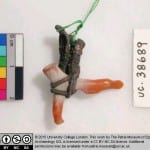Animal Healing: From Serpents to Coral
By ucramew, on 27 April 2015
A UCL undergraduate student visiting the Grant Museum recently asked me whether I had any insight into how past/present societies have awarded ‘animal objects’ — whether teddy bears that bring comfort to poorly children or exotic specimens used in traditional Chinese medicine — with the power to heal. He was researching this question for a medical humanities course and had come to the Grant to gaze on the hundreds of animal specimens the museum displays and garner some inspiration. It seemed to be such a broad question that at first I couldn’t think of any suggestions; once we talked it over, I realised that there’s a whole host of ways that animals (the dead, inanimate and the living) have been associated with healing.
Animals have been connected to beliefs about medicine and healing since time immemorial. Even our modern iconography, the easily recognisable Rod of Asclepius as a symbol for medicine, retains this connection.
The Rod of Asclepius is believed to have originated from one of two sources. The earliest Egyptian medical manuscript, the Ebers papyrus (1500 BCE), described a technique (still in use today) for the treatment of worms by wrapping emerging worms around the end of a staff. In Old Testament lore (possibly 1800 – 1200 BCE), Moses is also connected with a similar image: his bronze staff was coiled with a serpent, which had power to heal anyone who had been poisoned by snake venom.
From either or both of these sources, the Rod of Asclepius may have emerged. Asclepius was revered in The Iliad (circa 750 – 650 BCE) as a great healer, but very much mortal. However, he was later worshipped as the son of Apollo and the patron of physicians, particularly of those who healed the vulnerable and the poor. According to Greco-Roman mythology, Asclepius killed a snake with his staff whilst he was examining a man who had been struck by one of Zeus’s lightning bolts. Miraculously, another snake appeared on the scene, healing the dead snake with herbs and restoring it to life. Inspired by the snake, Asclepius was also able to heal the man struck by lightning. Therefore, in honour of the snake Asclepius adopted the snake coiled on a staff as his own emblem.
In the Petrie Museum’s collections there are further suggestions of the association that societies have made between the serpent and medical belief. One object is the Silver Uraeus ‘serpent amulet’ (UC38689) which appears to be a coiled snake twisted around a red coral twig. Amulets were considered to be protective objects by ancient Egyptians as well as serving an aesthetic function, by communicating the economic and social status of an individual. A similar specimen of coral, which are made up of thousands of tiny animals called polyps, can be found in the Grant Museum (C274).
Another amulet (UC2341) in the Petrie collection depicts Horus, the god of kingship and celestial power, standing on two crocodiles with an oryx (antelope) and serpents in each hand. According to the catalogue, the hieroglyphs on the back and sides of the amulet are words to be spoken in defence of health, but mainly against snake and scorpion bites. In this example, it seems that the icon of the serpent is invoked to represent a specific type of protection against, and healing for, snake venom.
The association between the serpent and medicine survived for thousands of years, but so did the use of coral in protective amulets. In the Victoria and Albert Museum several examples of coral amulets survive in their collection. Their curators believe that stones with distinctive colours and patterns have been used as protective amulets ‘since the dawn of time’. Specimens of green or red coral or malachite were particularly associated with health and healing. In the early modern world (circa 1500 – 1800 CE) coral was also used to create amulets to protect against the ‘evil eye’ and witches who were believed to wield power to curse their victims with sickness and even death. In the early modern world, witchcraft presented a serious and very real threat, creating circumstances where actual illness became entangled with superstitious belief.
Infants and pregnant women were believed to be particularly vulnerable to witchcraft. This stemmed, Lyndal Roper suggests, from contemporary belief about the nature of witches: ’Witches were stereotypically old women, unable to have children any longer, and it was their infertile, hag-like bodies that impelled them enviously to attack the fertility of others. They would creep into the marital bedchamber at night, to press down on pregnant women, leaving them feeling oppressed, or ‘hag-ridden’, as we might say.’ For this reason, it became widespread across Europe to create coral apotropaic items, such as rattles and teething rings for small children. Coral was also sometimes hung around their necks for protection. As Roper has put it, ‘the imaginative connection between witches, birth, and envy lies close to the surface of many witch trials’.
When studying this part of history, I was always fascinated by the idea that people really did make themselves ill and presented real symptoms as a result of fear about witchcraft — they were completely convinced that a curse was upon them. But if they could make themselves sick, they could also make themselves better by firm belief in the protective value of coral.
In both the Petrie and Grant collections there are representations of human belief in the power of the natural world to protect and heal. My own interest drew me to amulets and coral: there are intriguing similarities in the amulets from ancient Egypt to early modern Europe, and I find it fascinating to think about the emotional life of such objects — how they made their wearers feel, the ideas and beliefs they communicated to others. However, there are many more ways that visitors could reimagine this topic and I would urge you to do so.
Sources:
Katrin MacPhee, ‘Snakes, Mistakes, and Mythology! The Use of the Rod of Asclepius and the Caduceus in Modern Medicine’
Kristen Elise, ‘What a Difference a Snake Makes: The Caduceus Versus the Rod of Asclepius’
http://www.kristenelisephd.com/2013/10/what-difference-snake-makes-caduceus.html
Lyndal Roper, The Witch in the Western Imagination, (University of Virginia Press: London, 2012).
 Close
Close








